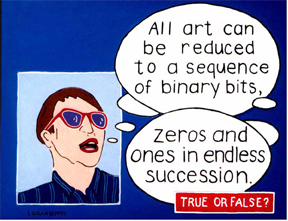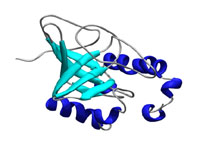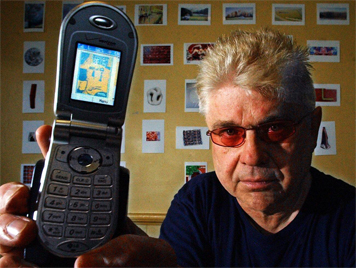The story of The Digital Museum of Modern Art is the story of its creator: W. Logan Fry. He had been a lawyer, artist and weaver, and by 1992, was weaving the patterns of microchips, which became part of the permanent collections of some of America's great art museums, including the Smithsonian American Art Museum and the Fine Arts Museums of San Francisco. Negroponte's “Being Digital” was also the impetus for the creation of The Digital Museum of Modern Art. In the book, at p. 57-58 (paperback), Negroponte said:
The Digital Museum of Modern Art wasn't a physical building, composed of stone, steel and glass, it was a "virtual" building, a building built from zeros and ones. You couldn't feel it or touch it, but you could be fully immersed in it. The museum’s first virtual exhibition was hosted by The Beecher Center at The Butler Institute of American Art, Youngstown, Ohio, in the exhibition: “Digital Artists: Recent Works” from August 28, 2002, through 2002. Both the exterior and interior of DMoMA was shown, including exhibits featuring painting, weaving, digital screens, and film. Given the technical limitations of the day, it was in very small format. The following year, the museum entered cyberspace, as announced in Rhizome: “Digital Museum of Modern Art Launches in Cyberspace,” August 28, 2003. Rhizome champions born-digital art and culture through commissions, exhibitions, scholarship, and digital preservation. Founded by artist Mark Tribe as a listserve including some of the first artists to work online, Rhizome has played an integral role in the history of contemporary art engaged with digital technologies and the internet. William J. Mitchell, former Dean, School of Architecture and Planning, MIT, used the virtual representation of DMoMA to illustrate his definition of E-Topia in Atributos Urbanos. The third principle of E-Topia refers to the "smart functioning" of its spaces. The physical buildings of this cybercity will be smart constructions that interact with their inhabitants by means of screens, sensors and devices, connected in a network to make up a virtual nervous system.
Nicholas Negroponte foresaw it 27 years ago: the leverage of maintaining a physical museum would soon disappear, and the museum would also become an electronic venue brought directly to the public by a personal phone or digital device. The Digital Museum of Modern Art has been at the forefront of these changes
|



